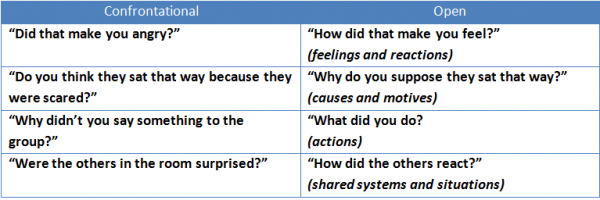What kinds of leadership questions are useful for managing people effectively? In my previous posts about leading by asking questions, I described four kinds of inquiry questions:
- Open
- Diagnostic
- Confrontational
- Process-oriented
In order to manage people well by asking good leadership questions, the questions should be genuine, based on curiosity and without an agenda. Effective leaders master the art of “humble inquiry,” says Edgar H. Schein, PhD, an MIT Sloan School of Management professor emeritus and consultant.
In his book, Humble Inquiry: The Gentle Art of Asking Instead of Telling (Berrett-Koehler Publishers, 2013), Dr. Schein describes inquiry as “the art of drawing someone out, of asking questions to which you do not already know the answer, of building a relationship based on curiosity and interest in the other person.”
I suggest that leaders and managers who ask open questions with genuine interest and curiosity will build better, more trusting relationships with the people who work for them. This kind of inquiry inspires high performance because it brings out the best in people. There are other types of questions that are useful in appropriate situations.
Diagnostic Inquiry
It’s easy to veer off the path of genuinely open inquiry by homing in on a particular detail. Doing so may steer the conversation in a different direction and inadvertently return control to you.
As a leader, your perceived position may interfere with your conversation partner’s mental processes. This is neither right nor wrong, but recognize that you’ve left the realm of open inquiry. You’re now engaged in diagnostic inquiry.
Determine why you’re steering the conversation in this direction. Are you trying to get the job done, or are you inappropriately indulging your curiosity, or perhaps looking for intellectual flaws in the other person?
Confrontational Inquiry
Leaders sometimes insert their own ideas in the form of a leading or rhetorical question. By doing so, you’re tacitly giving advice and trying to influence your conversation partner’s answers. Your partner may experience this as manipulative and become resistant.
Look at the differences in how these questions are asked:
Confrontational questions can be open, as long as your conversation partner believes you’re trying to be helpful. Timing, tone of voice and other cues will establish your motive.
Process-Oriented Inquiry
Leaders practice process-oriented inquiry when their focus is the conversation itself. This may be helpful when a discussion starts badly. You can explore solutions by asking:
- “What’s happening right now?”
- “Are you feeling defensive?”
- “Have I offended you in some way?”
- “Are we OK?”
- “Anything else we need to say about this?”
- “What should I be asking now?”
It’s Countercultural
As the researchers who interviewed Dr. Schein reinforce in the Academy of Management Learning and Education:
“In most cultures, asking and accepting help from a subordinate or admitting not knowing the answer to a subordinate’s question disrupts the normal social order. It is ‘countercultural,’ thus often ‘not done,’ and might be felt by the leader as a loss of face and even career-threatening in highly political organizations.”
From the work I do in organizations, I see there is an underlying attitude of competitive one-upmanship that plagues senior leadership teams. This will stifle genuine inquiry unless you address underlying attitudes.
Focus on being curious about others, without letting personal expectations and judgments cloud communication. Enjoy the benefits of asking meaningful questions in a psychologically safe work environment.
It takes discipline and practice to allow yourself to appear vulnerable. Consider working with an executive coach to break through any vulnerability barriers and perfect the art of open inquiry, as Dr. Schein describes in his book Humble Inquiry.
What are your thoughts about this? I’d love to hear from you. I can be reached here or on LinkedIn.

Did You Enjoy This Article?
Join thousands of other smart business owners like yourself & get our Proffittable Times newsletter.
It's filled with actionable content you can apply immediately.
Sign up now to get started!
– Coach Nancy











